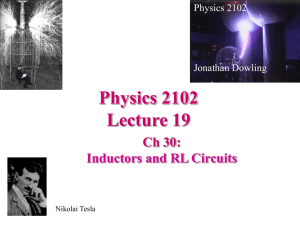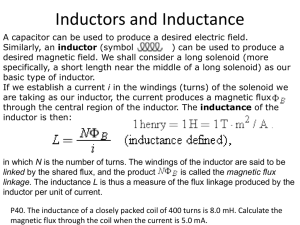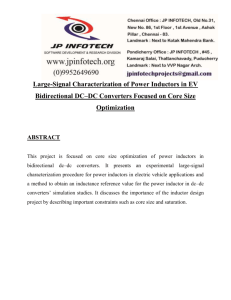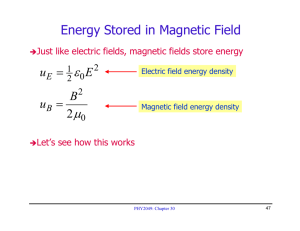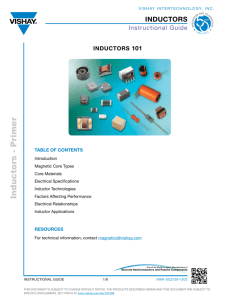Physics 2102 Lecture 19 - LSU Physics & Astronomy
advertisement
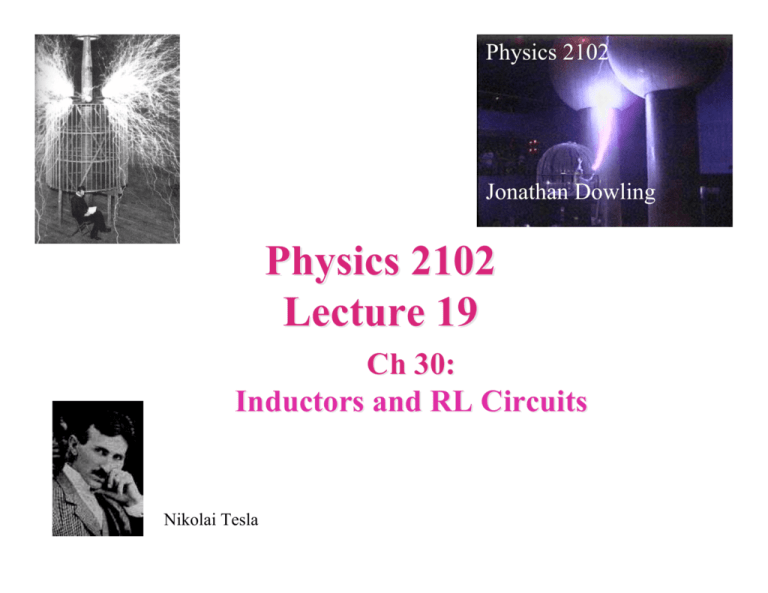
Physics 2102 Jonathan Dowling Physics 2102 Lecture 19 Ch 30: Inductors and RL Circuits Nikolai Tesla What are we going to learn? A road map • Electric charge Electric force on other electric charges Electric field, and electric potential • Moving electric charges : current • Electronic circuit components: batteries, resistors, capacitors • Electric currents Magnetic field Magnetic force on moving charges • Time-varying magnetic field Electric Field • More circuit components: inductors. • Electromagnetic waves light waves • Geometrical Optics (light rays). • Physical optics (light waves) Inductors: Solenoids Inductors are with respect to the magnetic field what capacitors are with respect to the electric field. They “pack a lot of field in a small region”. Also, the higher the current, the higher the magnetic field they produce. Capacitance → how much potential for a given charge: Q=CV Inductance → how much magnetic flux for a given current: Φ=Li Using Faraday’s law: di EMF = ! L dt Tesla " m 2 Units : [ L] = ! H (Henry) Ampere Joseph Henry (1799-1878) “Self”-Inductance of a solenoid • Solenoid of cross-sectional area A, length l, total number of turns N, turns per unit length n • Field inside solenoid = µ0 n i • Field outside ~ 0 i ! B = NAB = NAµ 0 ni = Li 2 N L = “inductance” = µ 0 NAn = µ 0 A l di EMF = ! L dt • • Example The current in a 10 H inductor is decreasing at a steady rate of 5 A/s. If the current is as shown at some instant in time, what is the magnitude and direction of the induced EMF? (a) 50 V (b) 50 V i • Magnitude = (10 H)(5 A/s) = 50 V • Current is decreasing • Induced emf must be in a direction that OPPOSES this change. • So, induced emf must be in same direction as current The RL circuit • • • Set up a single loop series circuit with a battery, a resistor, a solenoid and a switch. Describe what happens when the switch is closed. Key processes to understand: – What happens JUST AFTER the switch is closed? – What happens a LONG TIME after switch has been closed? – What happens in between? Key insights: • If a circuit is not broken, one cannot change the CURRENT in an inductor instantaneously! • If you wait long enough, the current in an RL circuit stops changing! At t=0, a capacitor acts like a wire; an inductor acts like a broken wire. After a long time, a capacitor acts like a broken wire, and inductor acts like a wire. RL circuits In an RL circuit, while “charging” In an RC circuit, while charging, (rising current), emf = Ldi/dt and the Q = CV and the loop rule mean: loop rule mean: • charge increases from 0 to CE • magnetic field increases from 0 to B • current decreases from E/R to 0 • current increases from 0 to E/R • voltage across capacitor • voltage across inductor increases from 0 to E decreases from −E to 0 Example Immediately after the switch is closed, what is the potential difference across the inductor? (a) 0 V (b) 9 V (c) 0.9 V 10 Ω 9V 10 H • Immediately after the switch, current in circuit = 0. • So, potential difference across the resistor = 0! • So, the potential difference across the inductor = E = 9 V! Example 3V 40 Ω • Immediately after the switch is 10 Ω closed, what is the current i through the 10 Ω resistor? (a) 0.375 A (b) 0.3 A • Immediately after switch is closed, (c) 0 current through inductor = 0. • Hence, current trhough battery and through 10 Ω resistor is i = (3 V)/(10Ω) = 0.3 A • Long after the switch has been closed, what is the current in the 40Ω resistor? (a) 0.375 A • Long after switch is closed, potential across inductor = 0. (b) 0.3 A • Hence, current through 40Ω resistor = (c) 0.075 A (3 V)/(40Ω) = 0.075 A 10 H “Charging” an inductor • How does the current in the circuit change with time? i di ! iR + E ! L = 0 dt Rt ' & # E L i = $$1 ' e !! R% " “Time constant” of RL circuit = L/R i(t) Small L/R E/R Large L/R t “Discharging” an inductor The switch is in a for a long time, until the inductor is charged. Then, the switch is closed to b. i What is the current in the circuit? Loop rule around the new circuit: di iR + L = 0 dt E i= e R Rt ! L i(t) Exponential discharge. E/R t Inductors & Energy • Recall that capacitors store energy in an electric field • Inductors store energy in a magnetic field. di E = iR + L dt di 2 (iE ) = i R + Li dt ( ) i 2 & d Li # 2 (iE ) = i R + $$ !! dt % 2 " ( ) Power delivered by battery = power dissipated by R + (d/dt) energy stored in L Example • • • The switch has been in position “a” for a long time. It is now moved to position “b” without breaking the circuit. What is the total energy dissipated by the resistor until the circuit reaches equilibrium? 10 Ω 9V 10 H • When switch has been in position “a” for long time, current through inductor = (9V)/(10Ω) = 0.9A. • Energy stored in inductor = (0.5)(10H)(0.9A)2 = 4.05 J • When inductor “discharges” through the resistor, all this stored energy is dissipated as heat = 4.05 J. E=120V, R1=10Ω, R2=20Ω, R3=30Ω, L=3H. 1. 2. 3. 4. 5. What are i1 and i2 immediately after closing the switch? What are i1 and i2 a long time after closing the switch? What are i1 and i2 1 second after closing the switch? What are i1 and i2 immediaately after reopening the switch? What are i1 and i2 a long time after reopening the switch?

